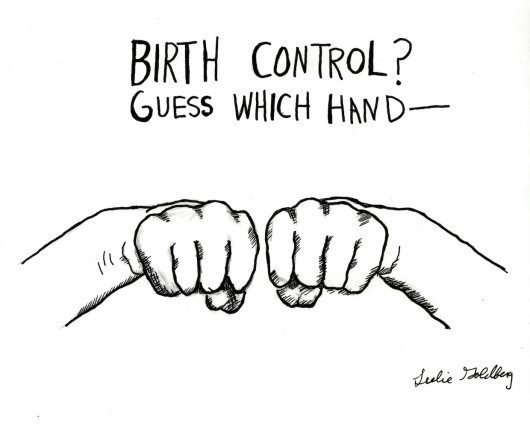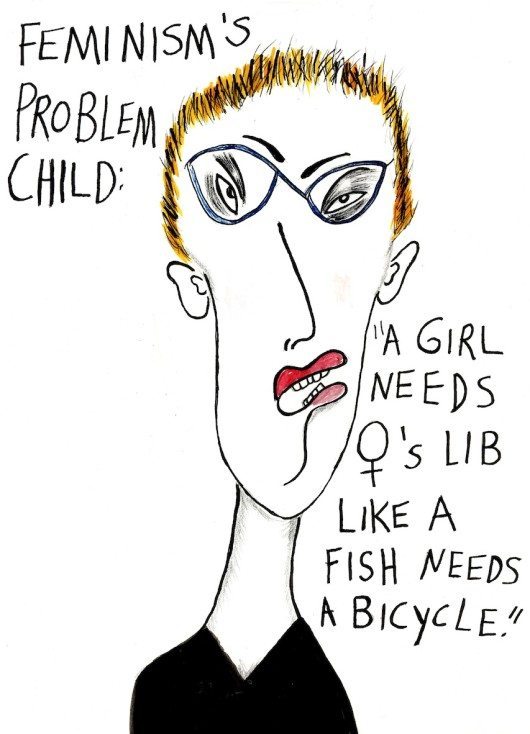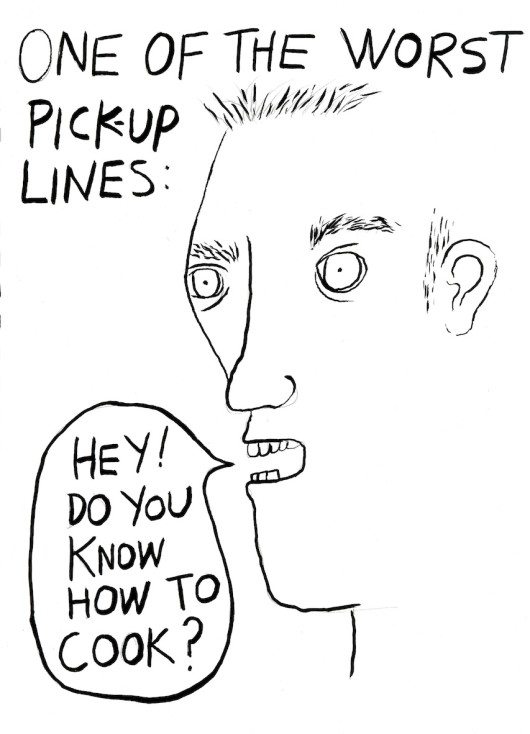FOR THE LAST FEW YEARS my work has argued for the protection of farmed animals, not only bad treatment on farms, but also the ultimate bad treatment—slaughter itself, Yet, my concerns extend to all animals including humans. The same fist of domination and oppression that menaces animals also menaces women, and other groups. ‘A feminist-vegetarian critical theory begins…with the perception that women and animals are similarly positioned in a patriarchal world, as objects rather than subjects,’ wrote Carol Adams in her scholarly The Sexual Politics of Meat.
When WEAD organizers asked if I might come up with some feminist cartoons for consideration, I jumped at the opportunity. Of late, women in the United States are being attacked from every side by a powerful conservative block. Like a lot of women I’ve been shocked by this onslaught. I had believed that rights like birth control, abortion and equal pay for equal work had been settled in this country. Obviously not.
While clearly we have trouble here, America is practically a paradise for women when compared to other countries where women are murdered for infidelity or for being raped. The myriad horrors women still suffer on this planet including child marriage, sex slavery, illiteracy and denial of basic human rights defy imagination or even comprehension.
My work doesn’t address those severe and deeply troubling conditions. As a white person, as an American, as a Northern Californian, as a heterosexual person, as an able-bodied person, as an economically secure person, as an educated person and as a human person, I’m privileged and for better or worse, my work reflects that.
While I am aware of my entitlement, I also want to speak up for those less entitled. I also love, dance, play, laugh, draw, sing, argue and, yes, cry. I suffer. I get depressed and frustrated at the pain and injustice I see all around me and within me.
And I have some tools I can use to contend with that pain including drawing and humor.
I. ART & HUMOR
‘LIFE IS HARD ENOUGH, and the only way to go through this is with humor,’ said the contemporary artist Ida Applebroog in an Art 21 video about her life. ‘It’s easier for me to go into a low comedy routine when I’m most angry.’
The marriage of comedy and anger and comedy and tragedy is well documented. When it comes to the tragic and, indeed, infuriating patriarchy here in the United States it’s not so hard to laugh. Men and women snared up in this ridiculous system of male supremacy are often, well, funny.
Humor and social justice movements are also often joined at the hip. The Guerrilla Girls, Molly Ivins, Ann Richards, Lenny Bruce, Dick Gregory, Whoopi Goldberg, Wanda Sykes, The Smothers Brothers, John Stewart, just to name a few, have wielded the comic sword against the powers that be. The result, in many instances, has been, well, hilarious.
While humor can be powerful, it’s not always the all-conquering weapon we hope it will be. For example, the Guerrilla Girls’ famous 1985 poster, ‘Do women have to be naked to get into U.S. museums? – Less than 3% of the artists in the Met. Museum are women, but 83% of the nudes are female.’ The art collective went back to the Met in 2005 and found that percentage of women artists had actually declined! However the number of male nudes had increased!
OK, a joke probably never swayed an election, passed a bond measure for school improvements or got women artists into the Metropolitan Museum of Art, but I think it can have its purpose. Writing about the healing power of humor, art critic Peter Schjeldahl: ‘It starts as a chuckle in the throat, a constant eddy of mirth that is the opposite of irony; rather than penetrate and expose incongruities, it heals and elides them, homogenizing all differences in the emulsion of a positive attitude…it is the sound of grown up children determined not to be afraid.’
Recently, I realized that a friend and I were acting like grown up children determined not to be afraid. I had bought a cup of too-strong coffee and I asked the counter person to put hot water in it. ‘Picky, picky,’ said my friend who happens to be an older woman like myself. ‘It’s the only power we have.’ We had a good laugh, numbing, for a bit, the fear of becoming old and irrelevant.
Humor builds community and can be encouraging for activists. On a certain level, the humor in my work offers me and my audience a little break from the sorrow of sexism, and other ‘ism’s.’
[It is] the absence of feeling which usually accompanies laughter. It seems as though the comic could not produce its…effect unless it fell, so to say on the surface of a soul that is thoroughly calm and unruffled. Indifference is its natural environment, for laughter has no greater foe than emotion…To produce the whole of its effect, the comic demands something like a momentary anesthesia of the heart. Its appeal is to the intelligence, pure and simple. –Henri Bergson1
For most of my working life I’ve been a journalist, interested in the social and political issues of the day, as well as human psychology and the world of ideas. Even after I left professional journalism, that orientation has never left me. When I turned to painting and drawing, that interest in cultural, political and social issues pulled me toward drawing and cartooning and away from realistic rendering.
‘By deemphasizing the appearance of the physical world in favor of the idea of form, the cartoon places itself in the world of concepts,’ wrote Scott McCloud, author of ‘Understanding Comics: the Invisible Art.’
I love the intimacy, immediacy and spontaneity of drawing. My drawings come mostly from my imagination and often act as a personal Rorschach Test for me. I draw and I find out what I’m thinking and what I’m feeling. In that way I find a connection with the Dadaists and to some extent, the Surrealists.
‘[Drawing] is more immediate, spontaneous and suitable for experimentation, discovery and sometimes even protest, than painting or sculpture,’ wrote Leslie Jones in her introduction to a catalog for the Los Angeles County Museum exhibition, Drawing Surrealism.
II. HUMOR AND ACTIVISM
AT ONE TIME I DREW AND PAINTED about George Bush, Condoleezza Rice, Dick Cheney and their unholy war in Iraq. Later I became almost totally absorbed in the protection of farmed animals. I had seen the movie Food Inc. and was devastated when I saw what we, as a culture, are doing to animals, both in factory farms and on so-called ‘humane farms.’
I had recently moved to the East Bay of the Bay Area and I was looking for community and I was also looking for encouragement to turn my concerns for these much abused animals into some kind of visual culture. I was trying to figure out how one might become an activist artist.
I signed up for Andree Thompson and Sharon Siskin’s brilliant Eco Art Matters class at Laney College in Oakland. Since ecology addresses everybody in the ecosystem and because animal agriculture does tremendous damage to the environment, I thought my work would be consistent with the goals of the class.
It was and I was hugely inspired by these two very fine instructors to put my art to work. I drew. I made posters. I created vegan message T-shirts as well as a blog, Vicious Vegan, which contained both my drawing and writing.
Currently, I’m at work on a book of vegan drawings, as well as a book of feminist cartoons.
As I mentioned before, drawing and painting cartoons is a second career for me. After a successful freelance writing career placing articles in The New York Times, The San Francisco Chronicle, San Francisco Magazine and others, I worked a stint as a fashion editor for the Contra Costa Times. After that I moved over to the San Francisco Examiner and worked first as a feature writer and later as an investigative reporter. I was nominated for a Pulitzer Prize for a series I did on San Francisco’s 911 system.
My cartoons have been published in the West Marin Citizen and the San Francisco Bay Guardian. My art work has been exhibited in several galleries included the Arts Guild of Sonoma. Two pieces of mine were selected for the 2005 Sonoma Valley Museum of Art Biennial. I was also chosen to participate in the SE Portland Art Walk. My work will be displayed at this year’s National Bioneers Conference in Marin County.
I recently graduated from Goddard College with an MFA in Interdisciplinary Art. I’m a mother, a grandmother and a member of the animal activist group, Direct Action Everywhere. I live El Cerrito, CA with my husband Michael Goldberg and a dog named Pearl and a cat named Barky.
I’m happy to present my drawings, ‘Things That Bug the Hell Out of Women,’ in this issue of WEAD.
END NOTES
1 Laughter: an Essay on the Meaning of the Comic (from ‘The Artist’s Joke’), Henri Bergson.





